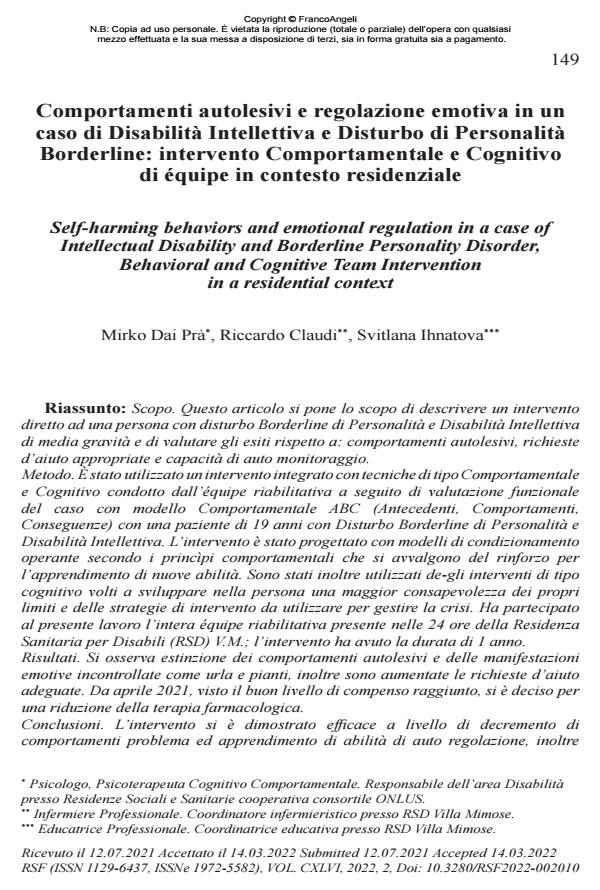Self-harming behaviors and emotional regulation in a case of Intellectual Disability and Borderline Personality Disorder, Behavioral and Cognitive Team Intervention in a residential context
Journal title RIVISTA SPERIMENTALE DI FRENIATRIA
Author/s Mirko Dai Prà, Riccardo Claudi, Svitlana Ihnatova
Publishing Year 2022 Issue 2022/2
Language Italian Pages 23 P. 149-171 File size 247 KB
DOI
DOI is like a bar code for intellectual property: to have more infomation
click here
Below, you can see the article first page
If you want to buy this article in PDF format, you can do it, following the instructions to buy download credits

FrancoAngeli is member of Publishers International Linking Association, Inc (PILA), a not-for-profit association which run the CrossRef service enabling links to and from online scholarly content.
Aim. This work aims to describe a therapeutic intervention with a person suffering from Borderline Personality disorder and Intellectual Disability of medium severity and to evaluate the results in terms of self-injurious behavior (SIB), ap-propriate requests for help and self-monitoring skills. Method. A Behavioral and Cognitive integrated intervention was conducted by the rehabilitation team. This was performed according to a functional assessment of the case with the ABC Behavioral Model (Antecedent, Behavior, Consequences) with a 19-year-old patient with Borderline personality disorder and moderate Intellectual Disability. The intervention was designed with operative conditioning models and behavioral principles were followed which make use of reinforcing the learning of new skills. Cognitive interventions aimed at achieving greater awareness of person’s limits and learn mastery intervention strategies. The entire rehabilitation team of a residential structure RSD V.M. was present within 24 hours, the intervention lasted for 1 year. Results. During the intervention self-damaging behaviors and uncontrolled emotional manifestations such as screaming and crying extinguished, and requests for adequate help have increased. From April 2021, given the good level of compensation achieved, it was decided to reduce drug therapy. Conclusions. The intervention proved to be effective in terms of decreas-ing problematic behaviors and learning self-regulation skills, and the results ob-tained led to an initial decrease in the drug therapy. The work offers food for thought relating to the effectiveness of the intervention with people with Intellec-tual Disabilities and Borderline Personality disease in a residential setting.
Keywords: Self injury, Borderline, Intellectual Disability, Behavior Cognitive, équipe.
Mirko Dai Prà, Riccardo Claudi, Svitlana Ihnatova, Comportamenti autolesivi e regolazione emotiva in un caso di Disabilità Intellettiva e Disturbo di Personalità Borderline: intervento omportamentale e Cognitivo di équipe in contesto residenziale in "RIVISTA SPERIMENTALE DI FRENIATRIA" 2/2022, pp 149-171, DOI: